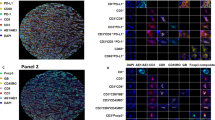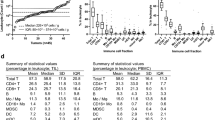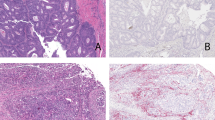Abstract
Perforin (PFP) is a cytotoxic protein released from killer cells. PFP immunoreactivity in human peripheral blood lymphocytes (PBL) and tumour infiltrating lymphocytes (TIL) was investigated immunocytochemically with the aid of an anti-PFP monoclonal antibody. PFP was detected in the cytoplasm of 10% of PBL. We performed a double staining of PFP+ cells with Leu11b/CD16, Leu2a/CD8, or Leu3a/CD4 and showed that PFP was produced by 9% of CD8+ cells and 18% of CD16+ cells but not by CD4+ cells. In 28 colorectal cancer tissues, PFP immunoreactivity was observed in the lymphocytes infiltrating to the tumour stroma. The PFP+ cells were most numerous in Dukes A and decreased in number according to the progression of tumours. The PFP+ cells in TIL exhibited the same phenotypes as those in PBL but the PFP+ cells were more numerous in CD8+ cells than in CD16+ cells at all stages. This study represents the first evidence that PFP is mainly secreted from CD8+ cells in tumour tissues. It is hypothesised that the decrease in the number of PFP+ cells in accordance with tumour progression may reflect the suppression of the hosts local immunity.
This is a preview of subscription content, access via your institution
Access options
Subscribe to this journal
Receive 24 print issues and online access
$259.00 per year
only $10.79 per issue
Buy this article
- Purchase on Springer Link
- Instant access to full article PDF
Prices may be subject to local taxes which are calculated during checkout
Similar content being viewed by others
Author information
Authors and Affiliations
Rights and permissions
About this article
Cite this article
Nakanishi, H., Monden, T., Morimoto, H. et al. Perforin expression in lymphocytes infiltrated to human colorectal cancer. Br J Cancer 64, 239–242 (1991). https://doi.org/10.1038/bjc.1991.283
Issue Date:
DOI: https://doi.org/10.1038/bjc.1991.283
This article is cited by
-
Gene therapy of prostate cancer using liposomes containing perforin expression vector driven by the promoter of prostate-specific antigen gene
Scientific Reports (2022)
-
Expression of chemokine receptor CCR5 correlates with the presence of hepatic molecular metastases in K-ras positive human colorectal cancer
Journal of Cancer Research and Clinical Oncology (2011)
-
Low expression of chemokine receptor CCR5 in human colorectal cancer correlates with lymphatic dissemination and reduced CD8+ T-cell infiltration
International Journal of Colorectal Disease (2010)
-
Cancer-induced Defective Cytotoxic T Lymphocyte Effector Function: Another Mechanism How Antigenic Tumors Escape Immune-mediated Killing
Molecular Medicine (2000)



